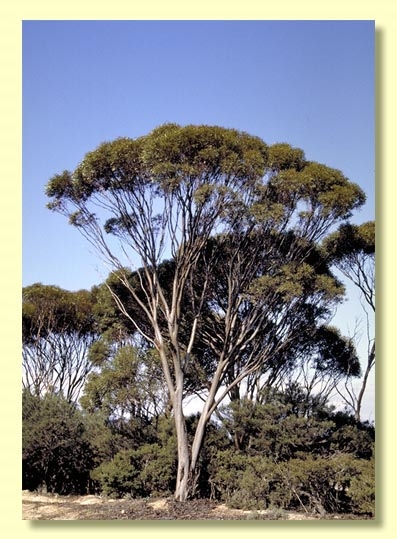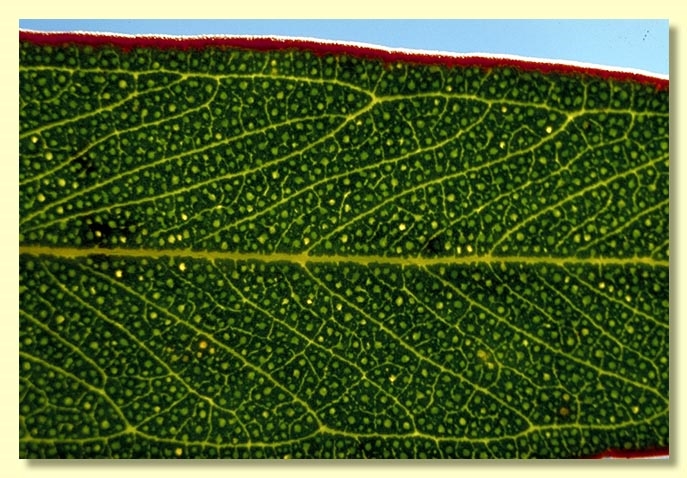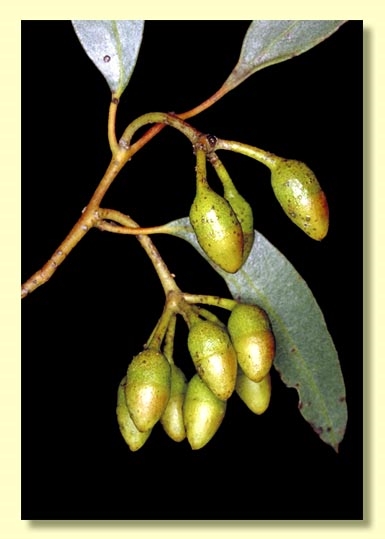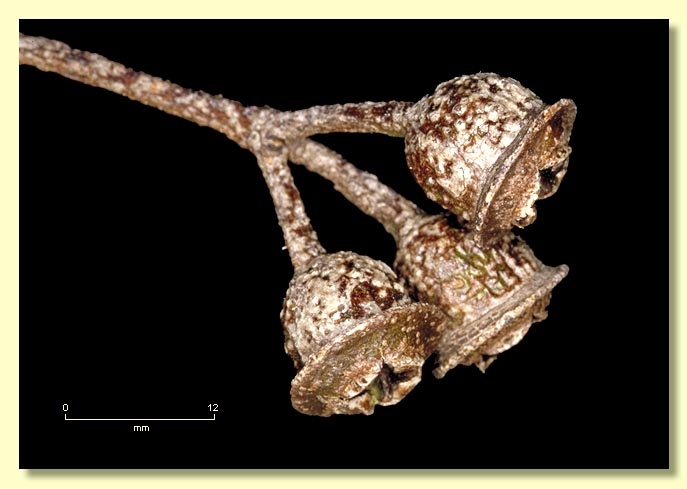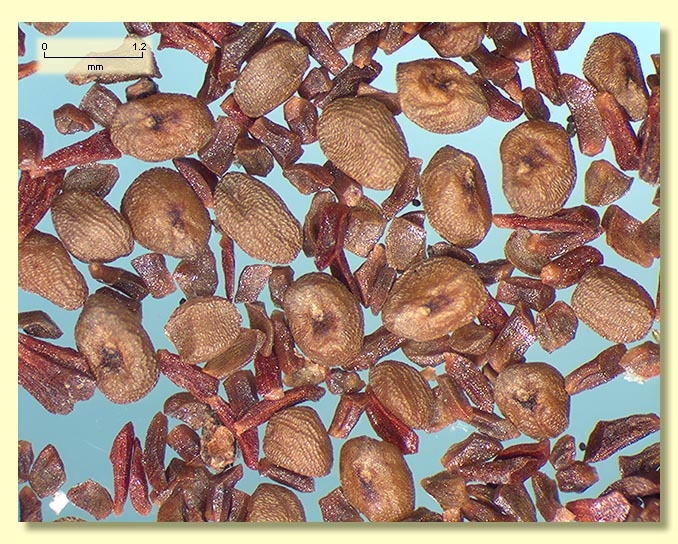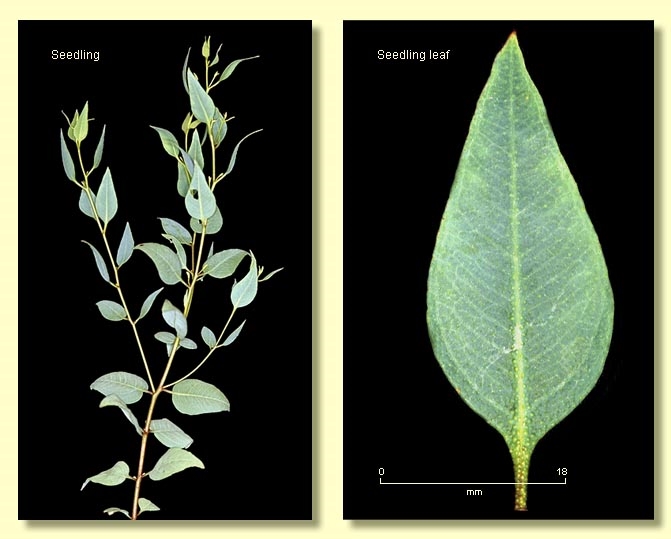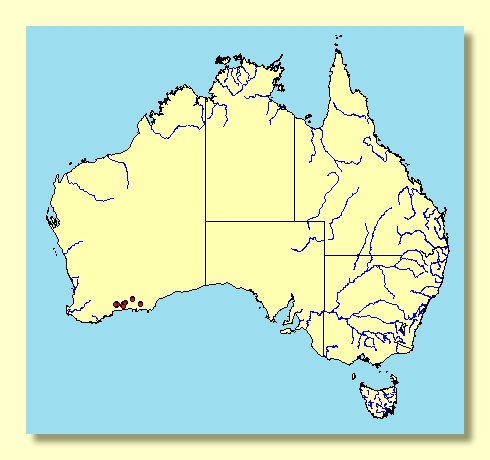Euclid - Online edition
Eucalyptus dielsii
Eucalyptus | Symphyomyrtus | Bisectae | Glandulosae | Elongatae
T: Salmon Gums, W.A., 13 Jan. 1925, C.A.Gardner 1051a per W.T.Brown s.n.; holo: PERTH.
Bark smooth throughout, dark grey over brownish and greenish.
Branchlets with oil glands in the pith.
Juvenile growth (coppice or field seedlings to 50 cm): not seen.
Adult leaves alternate, petioles 0.8–2.2 cm long; blade lanceolate, 5–10(11.5) cm long, 0.8–2 cm wide, base tapering to petiole, margin entire, apex acute, concolorous, green to blue-green, glossy, side-veins usually acute, reticulation sparse or obscure, intramarginal vein remote from margin, oil glands numerous, slightly irregular in shape.
Inflorescence axillary unbranched, pendulous, peduncles slender, 1.5–3.2 cm long, buds 7(9) per umbel, pedicels 1–1.4 cm long. Mature buds cylindrical to ovoid (1.1–1.9 cm long, 0.6–0.9 cm wide), scar present (outer operculum shed early), inner operculum conical, 1 or 2 outer stamens erect, most stamens variably to completely inflexed, anthers oblong, versatile, dorsifixed, dehiscing by longitudinal slits, style long and straight, stigma blunt, locules 4 or 5, the placentae each with 6 vertical rows of ovules. Flowers yellow to yellowish green.
Fruit down-turned, pedicellate (pedicels 1–1.5 cm long), stoutly cylindrical to hemispherical always with a marginal flange formed from the lateral spreading of the disc (look like bowler hats), 0.8–1.1 cm long, 1–1.4 cm wide, disc more or less level, valves 4 or 5, near rim level or slightly exserted.
Seeds brown, 0.8–2 mm long, ovoid to flattened-ovoid, dorsal surface clearly and shallowly reticulate, hilum ventral.
Cultivated seedlings (measured at node 10): cotyledons Y-shaped (bisected); stems rounded or square in cross-section usually scabrid; leaves always petiolate, opposite for ca 4 or 6 nodes then alternate, ovate, 3.5–5.5 cm long, 1.5–2.5 cm wide, dull, green. Leaves and stems scabrid at least until node 10.
Flowering has been recorded in November and January.
A mallet endemic to Western Australia, of scattered distribution in subcoastal areas from north-west of Ravensthorpe to north-east of Esperance. The bark is smooth and the adult leaves glossy, olive-green to green.
Eucalyptus dielsii belongs in Eucalyptus subgenus Symphyomyrtus section Bisectae subsection Glandulosae because the buds have an operculum scar, cotyledons are bisected and branchlets have oil glands in the pith. Within this large subsection (ca 80 species) Eucalyptus dielsii is closely related to a group of mallees or mallets (series Elongatae ) that is characterised by the glossy green leaf surface, leaves with many oil glands obscuring the reticulation but not the main side-veins, buds with very long conspicuous pedicels, short opercula, inflexed stamens and ovules in either six or eight vertical rows. There are five species in series Elongatae—E. cylindriflora, E. cerasiformis, E. dielsii, E. armillata and E. erythronema (with 2 subspecies) .
E. dielsii is unlikely to be confused with any other species because of its unusual fruit that is stoutly hemispherical with a narrow flange (like a small bowler hat). Its buds are ovoid and pendulous. Of the related species with pendulous bud clusters E. cerasiformis has small buds that are narrowed in the middle and urn-shaped fruit whilst E. erythronema has much larger buds and obconical fruit. The remaining species, E. cylindriflora, has cylindrical buds in erect clusters.

